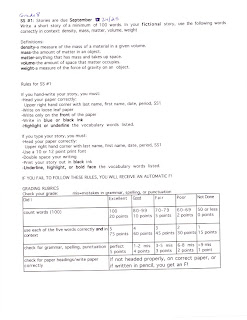 |
| These are the instructions for Short Story 1. Be sure to follow them and submit your story on the assigned date for your class. |
Students will be able to:
identify characteristics of chemical changes of matter.
-recognize examples of chemical changes.
-record observations of physical and chemical changes of matter.
-recognize examples of chemical changes.
-record observations of physical and chemical changes of matter.
Students completed the following bell ringer:
Erin places
some ice cubes into freshly made tea that is still quite warm. Which of the
following correctly describes what happens to the ice cubes?
A. Some of the heat from the tea is transferred to the ice
cubes and causes them to melt.
B. The temperature of the ice cubes remains the same as the
temperature of the tea drops.
C. The cold from the ice cubes is transferred into the tea
and causes the cubes to warm up and melt.
D. Heat is transferred between the ice cubes and
the tea, which causes the temperature of the tea to increase.
Students received the instructions for Short Story 1, which can be found at the top of this blog.
Period 1 was assigned HL 6, which is to read pages 302-305 in their text and to answer the questions from page 309 (1-6, letter answers only) on their own paper.
Students watched the BrainPop movie States of Matter. To view the video, click the link BrainPop and scroll down to the title States of Matter and click the link. Let the movie load and then watch.
Students then did the Discovery Education Exploration Changing States. Visit Dr. Gayden's Science Zone (drgcdms.podomatic.com) to access the site.Click the FIRST website listed. Be sure to NOT bother the code and to type in your first and last name. Then, click the login button. Once the page loads, click on either of the explorations Changing State and follow the directions. If you lost your handout, you can click the link under materials to find the handout.
If you complete the activity, go back to Dr. Gayden's Science Zone and click the second link. Draw the chart/table on the bottom of your handout and use the substances to complete the table.
